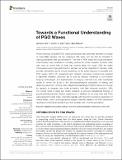| dc.contributor.author | Gott, Jarrod A. | en_US |
| dc.contributor.author | Liley, David T. J. | en_US |
| dc.contributor.author | Hobson, J. Allan | en_US |
| dc.date.accessioned | 2017-04-06T03:18:16Z | |
| dc.date.issued | 2017 | en_US |
| dc.identifier.citation | Gott, Jarrod A., David T. J. Liley, and J. Allan Hobson. 2017. “Towards a Functional Understanding of PGO Waves.” Frontiers in Human Neuroscience 11 (1): 89. doi:10.3389/fnhum.2017.00089. http://dx.doi.org/10.3389/fnhum.2017.00089. | en |
| dc.identifier.issn | | en |
| dc.identifier.uri | http://nrs.harvard.edu/urn-3:HUL.InstRepos:32071910 | |
| dc.description.abstract | Ponto-Geniculo-Occipital (PGO) waves are biphasic field potentials identified in a range of mammalian species that are ubiquitous with sleep, but can also be identified in waking perception and eye movement. Their role in REM sleep and visual perception more broadly may constitute a promising avenue for further research, however what was once an active field of study has recently fallen into stasis. With the reality that invasive recordings performed on animals cannot be replicated in humans; while animals themselves cannot convey experience to the extent required to elucidate how PGO waves factor into awareness and behavior, innovative solutions are required if significant research outcomes are to ever be realized. Advances in non-invasive imaging technologies and sophistication in imaging methods now offer substantial scope to renew the study of the electrophysiological substrates of waking and dreaming perception. Among these, Magnetoencephalogram (MEG) stands out through its capacity to measure deep brain activations with high temporal resolution. With the current trend in sleep and dream research to produce translational findings of psychopathological and medical significance, in addition to the clear links that PGO wave generation sites share, pharmacologically, with receptors involved in expression of mental illness; there is a strong case to support scientific research into PGO waves and develop a functional understanding of their broader role in human perception. | en |
| dc.language.iso | en_US | en |
| dc.publisher | Frontiers Media S.A. | en |
| dc.relation.isversionof | doi:10.3389/fnhum.2017.00089 | en |
| dc.relation.hasversion | http://www.ncbi.nlm.nih.gov/pmc/articles/PMC5334507/pdf/ | en |
| dash.license | LAA | en_US |
| dc.subject | Review | en |
| dc.subject | magnetoencephalogram | en |
| dc.subject | rapid eye movements | en |
| dc.subject | pontine-geniculate-occipital waves | en |
| dc.subject | 5-HT | en |
| dc.subject | vision | en |
| dc.title | Towards a Functional Understanding of PGO Waves | en |
| dc.type | Journal Article | en_US |
| dc.description.version | Version of Record | en |
| dc.relation.journal | Frontiers in Human Neuroscience | en |
| dash.depositing.author | Hobson, J. Allan | en_US |
| dc.date.available | 2017-04-06T03:18:16Z | |
| dc.identifier.doi | 10.3389/fnhum.2017.00089 | * |
| dash.contributor.affiliated | Hobson, John | |


